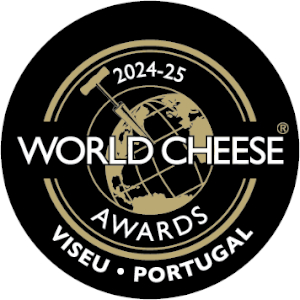We make a point of covering the luxe World Cheese Championship every year. One reason is, it gives us a chance to use adjectives such as ‘voluptuous’ that we wouldn’t get to use in any other context… But it’s also ‘a celebration of the world cheese community’…
 The team who created this year’s World Cheese Award Winner,
The team who created this year’s World Cheese Award Winner,
from Quinta do Pomar in the town of Soalheira, Portugal
This year’s overall World’s Best Cheese is a Portuguese creation, from a tiny rural dairy with only 10 employees. But a lot of heart, and hundreds of years of aggregate cheese making experience…
Superlatives proliferate…
Queijo de Ovelha Amanteigado from Quinta do Pomar in the town of Soalheira, Portugal, soared above 4,785 other cheeses from 47 countries to be crowned overall Champion at the 2024-2025 World Cheese Awards.
Made with vegetarian rennet created from thistles, the winner is described as a gooey, glossy, buttery cheese with a herby bitterness that’s typically served by slicing off the top [rind] and spooning out the center,” Correspondent wrote, for CNN.
“It’s quite balanced … voluptuous,” Portuguese cheese exporter Manuel Maia, one of the international panel of jurors, said. “It is a really sublime match of protein and fat. It’s really a fantastic cheese.”
Setting a benchmark
“It’s a celebration of the world cheese community,” says John Farrand, Managing Director of The Guild of Fine Food, the contest’s UK-based organizer. “Any award is important, especially for small produ-cers, as the world becomes an increasingly difficult place to move a cheese around.”
“From the simplest point of view,” he adds, “it’s a benchmark across the planet, across 47 countries. And if you’re a cheese maker, in a valley somewhere, with 12 goats, to get that seal of approval, that pat on the back, is great. And, of course, it will help them sell their cheese and stay in business.”
My take
I can think of many better ways to spend the hundreds of thousands of dollars it must take, altoge-ther, to stage the annual World Cheese Championship. But the cash isn’t coming out of my pocket. And I love to able to report that a small, local dairy won the honour – for the second year in a row. Which is a very unusual development, indeed, according to organizers.
Last year’s winner as Nidelven Blå, “a creamy semi-solid blue, [aged], cows’ milk cheese made by the tiny Gangstad Gårdsysteri creamery,” located just an hour outside the host city, Trondheim, in Nor-way. The championship is held in a different European city every autumn.
Disclaimer:
My soft spot for micro-creameries is a matter of heritage… My Dad’s Dad was brought up on an Eastern Ontario dairy farm in the late 19th century. Their milk went, every morning, 7 days a week, to the Rylestone Cheese Factory a couple of concession roads over, to be made into Cheddar using the same procedure his Northumbrian forebears used for centuries before, back in the North of England.
Rylestone had a catchment area for its milk consisting of fewer than a dozen farms owned by families which were all related by second- or third-degree blood bonds. And Dad’s Dad was the youngest of 7 employees at the age of 14, when he first joined up to learn cheese making the ‘family’ way.
There were 12 or 15 other small cheese factories across Northumberland and neighbouring Hastings counties at the turn of the last century. All but 4 had closed or merged by the recent Millennium. It warms my heart to know that micro-creameries are still thriving across Europe!
~ Maggie J.

